Comparative Analysis of Applied Learning Approaches in Three Programs
VerifiedAdded on 2021/02/19
|13
|4339
|41
Report
AI Summary
This report provides a comprehensive analysis of applied learning approaches across three contemporary programs: the Victorian Certificate of Applied Learning (VCAL) for schools, Vocational Training in Australia (VET) for higher education, and Adult Community Education (ACE) for community learning. The report begins with an introduction to applied learning, emphasizing its focus on practical application of skills and knowledge. The main body of the report offers detailed descriptions of each program, including their objectives, target audiences, and implementation strategies. The VCAL section highlights its 'hands-on' approach for senior secondary students, focusing on work-based, project-based, and service learning. The VET section explores its emphasis on vocational skills and industry partnerships, preparing students for specific careers. The ACE section focuses on providing accessible learning opportunities for adults in local communities, supporting skills development and social cohesion. Each program's section includes a critical analysis, discussing its strengths, weaknesses, and impact based on academic research and literature. The report examines the contemporary learning theories used in each program, such as feminist criticism, culture and social learning, and behaviourism, and concludes with a comparative summary of the applied learning approaches, highlighting their effectiveness and implications for educational practices.
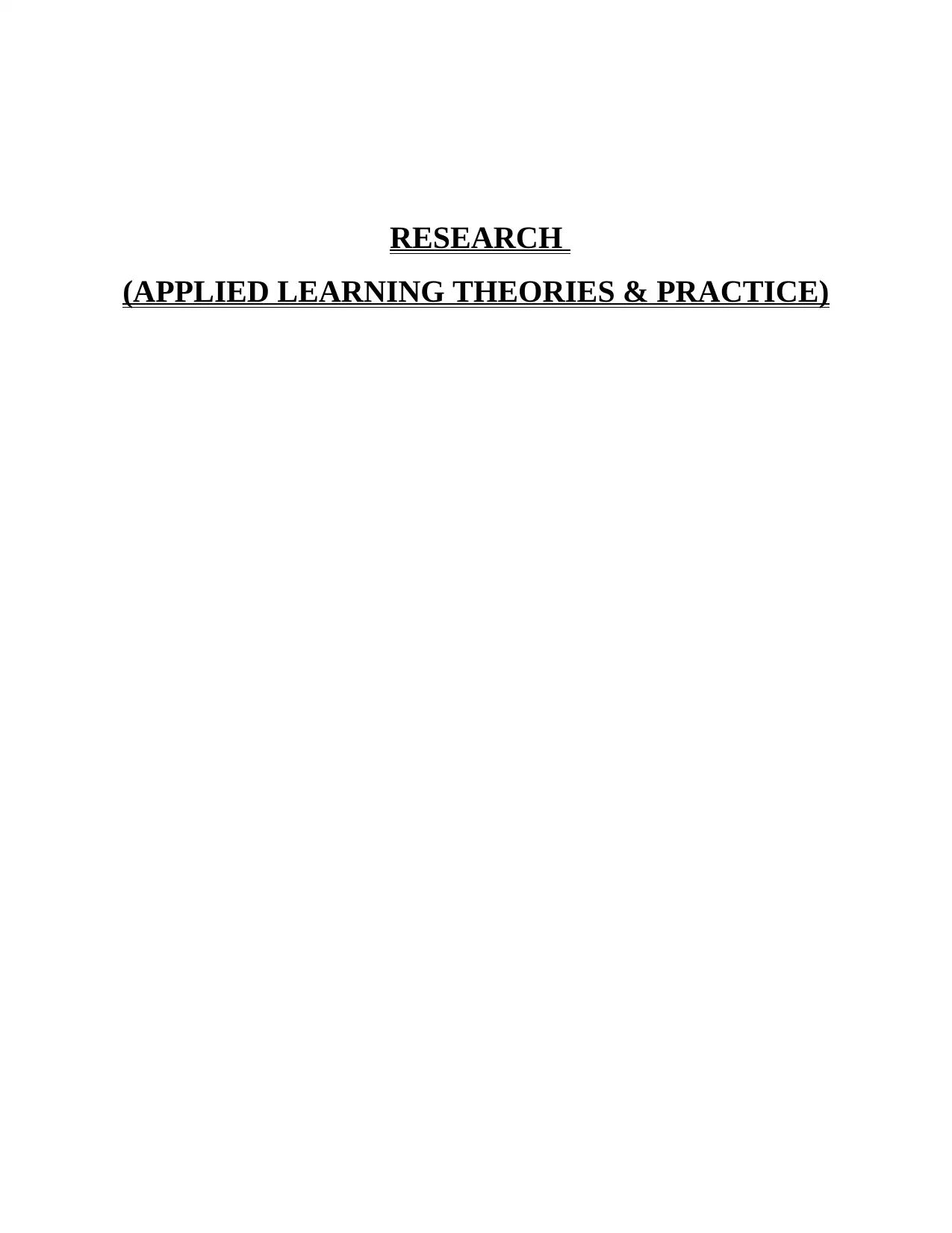
RESEARCH
(APPLIED LEARNING THEORIES & PRACTICE)
(APPLIED LEARNING THEORIES & PRACTICE)
Paraphrase This Document
Need a fresh take? Get an instant paraphrase of this document with our AI Paraphraser
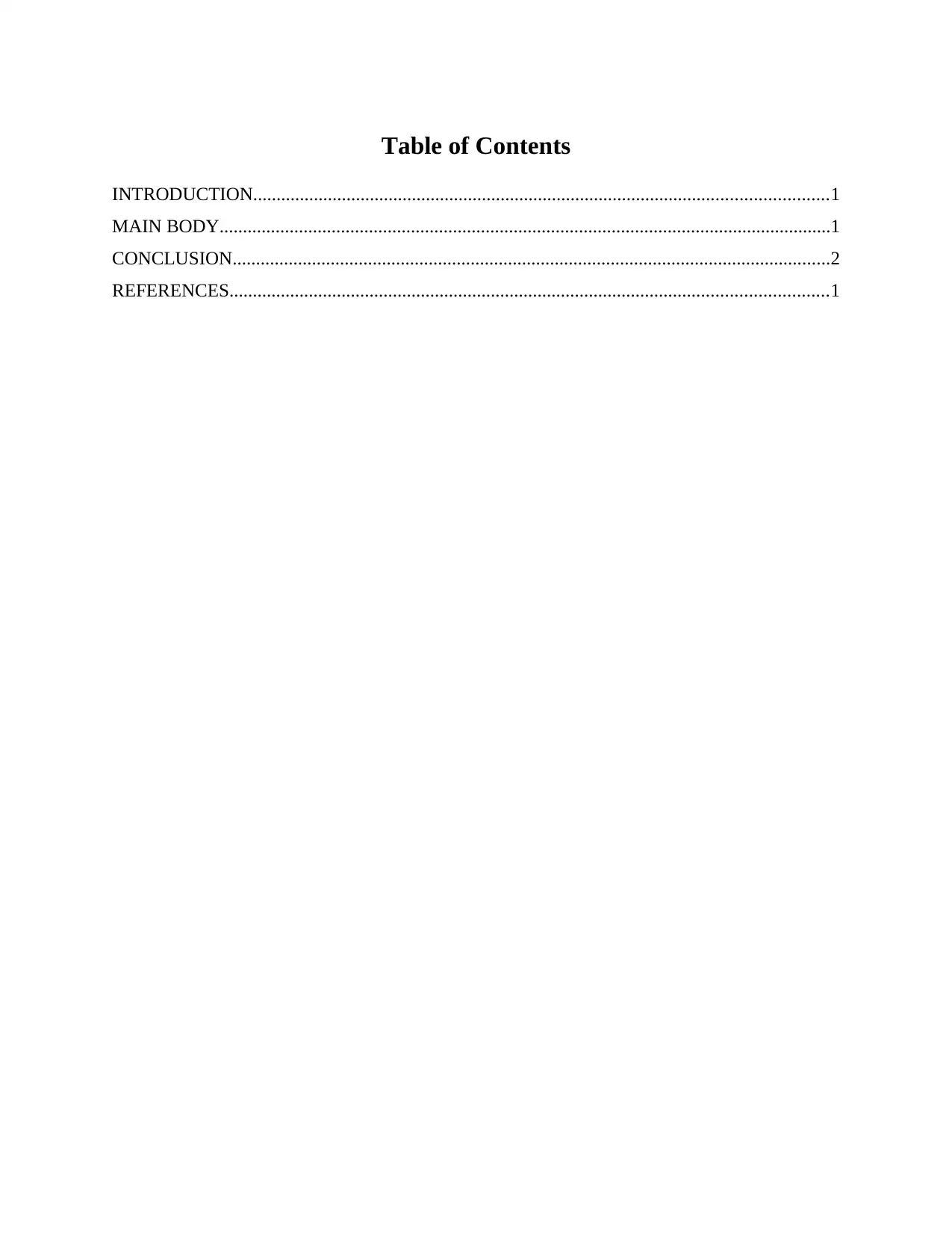
Table of Contents
INTRODUCTION...........................................................................................................................1
MAIN BODY...................................................................................................................................1
CONCLUSION................................................................................................................................2
REFERENCES................................................................................................................................1
INTRODUCTION...........................................................................................................................1
MAIN BODY...................................................................................................................................1
CONCLUSION................................................................................................................................2
REFERENCES................................................................................................................................1
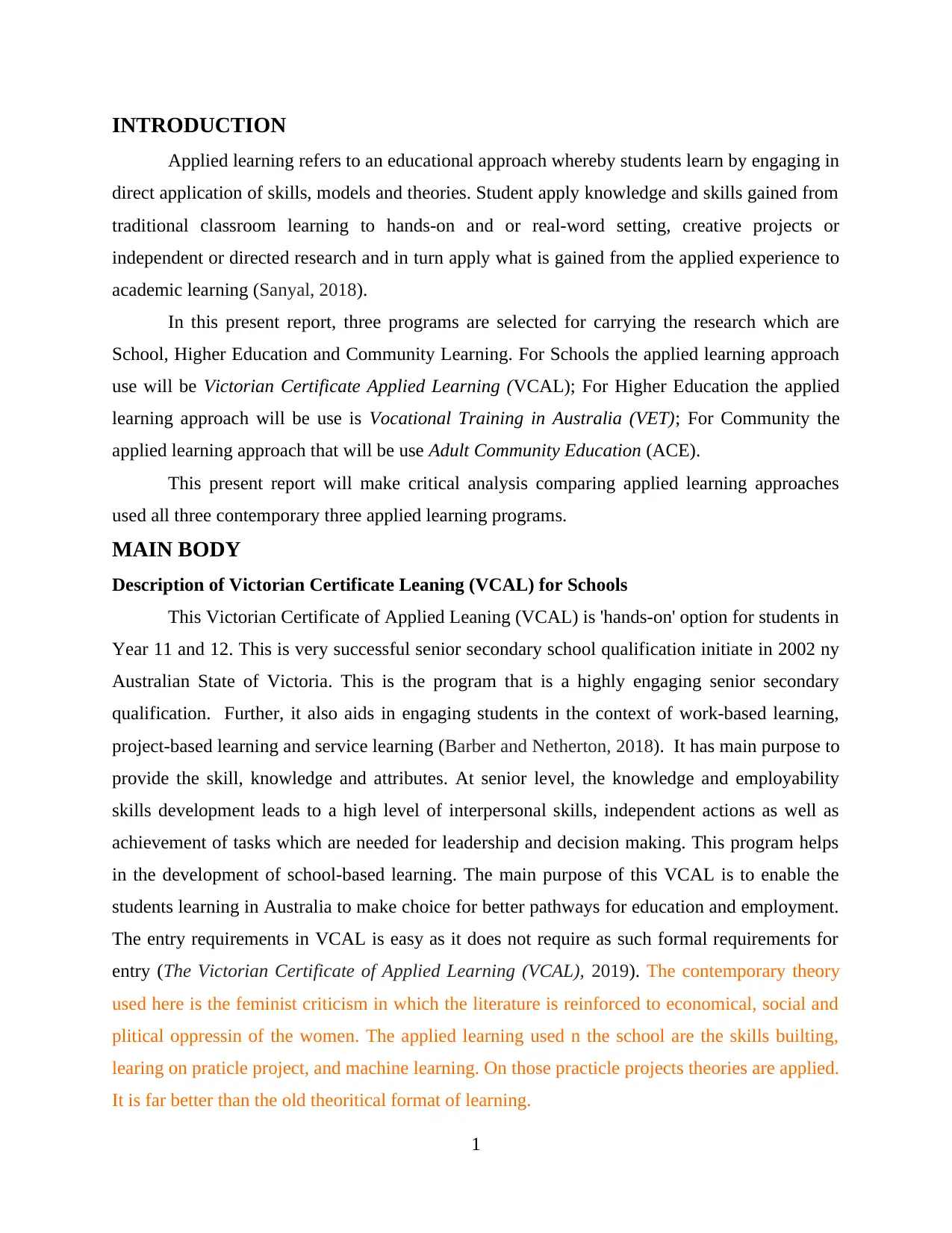
INTRODUCTION
Applied learning refers to an educational approach whereby students learn by engaging in
direct application of skills, models and theories. Student apply knowledge and skills gained from
traditional classroom learning to hands-on and or real-word setting, creative projects or
independent or directed research and in turn apply what is gained from the applied experience to
academic learning (Sanyal, 2018).
In this present report, three programs are selected for carrying the research which are
School, Higher Education and Community Learning. For Schools the applied learning approach
use will be Victorian Certificate Applied Learning (VCAL); For Higher Education the applied
learning approach will be use is Vocational Training in Australia (VET); For Community the
applied learning approach that will be use Adult Community Education (ACE).
This present report will make critical analysis comparing applied learning approaches
used all three contemporary three applied learning programs.
MAIN BODY
Description of Victorian Certificate Leaning (VCAL) for Schools
This Victorian Certificate of Applied Leaning (VCAL) is 'hands-on' option for students in
Year 11 and 12. This is very successful senior secondary school qualification initiate in 2002 ny
Australian State of Victoria. This is the program that is a highly engaging senior secondary
qualification. Further, it also aids in engaging students in the context of work-based learning,
project-based learning and service learning (Barber and Netherton, 2018). It has main purpose to
provide the skill, knowledge and attributes. At senior level, the knowledge and employability
skills development leads to a high level of interpersonal skills, independent actions as well as
achievement of tasks which are needed for leadership and decision making. This program helps
in the development of school-based learning. The main purpose of this VCAL is to enable the
students learning in Australia to make choice for better pathways for education and employment.
The entry requirements in VCAL is easy as it does not require as such formal requirements for
entry (The Victorian Certificate of Applied Learning (VCAL), 2019). The contemporary theory
used here is the feminist criticism in which the literature is reinforced to economical, social and
plitical oppressin of the women. The applied learning used n the school are the skills builting,
learing on praticle project, and machine learning. On those practicle projects theories are applied.
It is far better than the old theoritical format of learning.
1
Applied learning refers to an educational approach whereby students learn by engaging in
direct application of skills, models and theories. Student apply knowledge and skills gained from
traditional classroom learning to hands-on and or real-word setting, creative projects or
independent or directed research and in turn apply what is gained from the applied experience to
academic learning (Sanyal, 2018).
In this present report, three programs are selected for carrying the research which are
School, Higher Education and Community Learning. For Schools the applied learning approach
use will be Victorian Certificate Applied Learning (VCAL); For Higher Education the applied
learning approach will be use is Vocational Training in Australia (VET); For Community the
applied learning approach that will be use Adult Community Education (ACE).
This present report will make critical analysis comparing applied learning approaches
used all three contemporary three applied learning programs.
MAIN BODY
Description of Victorian Certificate Leaning (VCAL) for Schools
This Victorian Certificate of Applied Leaning (VCAL) is 'hands-on' option for students in
Year 11 and 12. This is very successful senior secondary school qualification initiate in 2002 ny
Australian State of Victoria. This is the program that is a highly engaging senior secondary
qualification. Further, it also aids in engaging students in the context of work-based learning,
project-based learning and service learning (Barber and Netherton, 2018). It has main purpose to
provide the skill, knowledge and attributes. At senior level, the knowledge and employability
skills development leads to a high level of interpersonal skills, independent actions as well as
achievement of tasks which are needed for leadership and decision making. This program helps
in the development of school-based learning. The main purpose of this VCAL is to enable the
students learning in Australia to make choice for better pathways for education and employment.
The entry requirements in VCAL is easy as it does not require as such formal requirements for
entry (The Victorian Certificate of Applied Learning (VCAL), 2019). The contemporary theory
used here is the feminist criticism in which the literature is reinforced to economical, social and
plitical oppressin of the women. The applied learning used n the school are the skills builting,
learing on praticle project, and machine learning. On those practicle projects theories are applied.
It is far better than the old theoritical format of learning.
1
⊘ This is a preview!⊘
Do you want full access?
Subscribe today to unlock all pages.

Trusted by 1+ million students worldwide
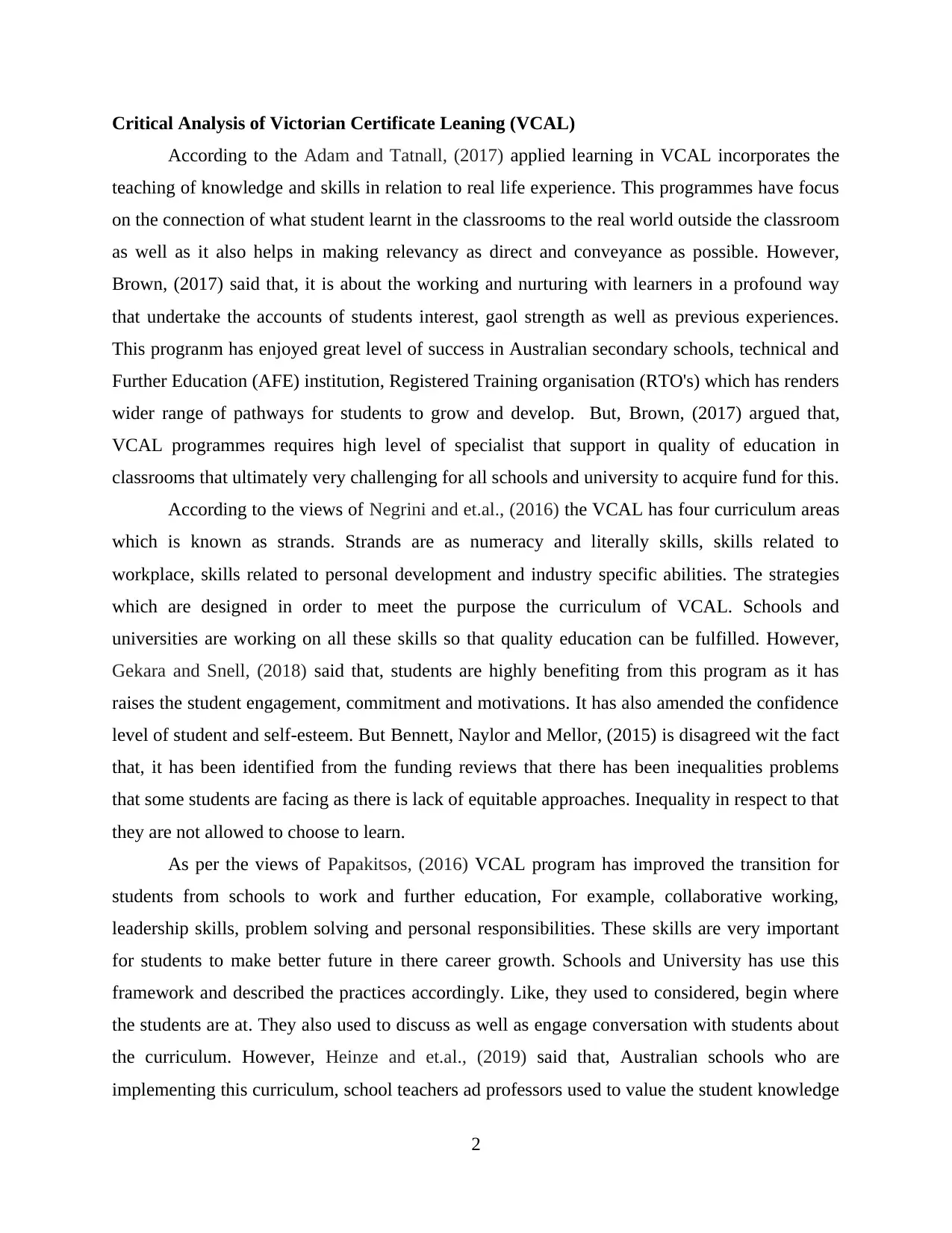
Critical Analysis of Victorian Certificate Leaning (VCAL)
According to the Adam and Tatnall, (2017) applied learning in VCAL incorporates the
teaching of knowledge and skills in relation to real life experience. This programmes have focus
on the connection of what student learnt in the classrooms to the real world outside the classroom
as well as it also helps in making relevancy as direct and conveyance as possible. However,
Brown, (2017) said that, it is about the working and nurturing with learners in a profound way
that undertake the accounts of students interest, gaol strength as well as previous experiences.
This progranm has enjoyed great level of success in Australian secondary schools, technical and
Further Education (AFE) institution, Registered Training organisation (RTO's) which has renders
wider range of pathways for students to grow and develop. But, Brown, (2017) argued that,
VCAL programmes requires high level of specialist that support in quality of education in
classrooms that ultimately very challenging for all schools and university to acquire fund for this.
According to the views of Negrini and et.al., (2016) the VCAL has four curriculum areas
which is known as strands. Strands are as numeracy and literally skills, skills related to
workplace, skills related to personal development and industry specific abilities. The strategies
which are designed in order to meet the purpose the curriculum of VCAL. Schools and
universities are working on all these skills so that quality education can be fulfilled. However,
Gekara and Snell, (2018) said that, students are highly benefiting from this program as it has
raises the student engagement, commitment and motivations. It has also amended the confidence
level of student and self-esteem. But Bennett, Naylor and Mellor, (2015) is disagreed wit the fact
that, it has been identified from the funding reviews that there has been inequalities problems
that some students are facing as there is lack of equitable approaches. Inequality in respect to that
they are not allowed to choose to learn.
As per the views of Papakitsos, (2016) VCAL program has improved the transition for
students from schools to work and further education, For example, collaborative working,
leadership skills, problem solving and personal responsibilities. These skills are very important
for students to make better future in there career growth. Schools and University has use this
framework and described the practices accordingly. Like, they used to considered, begin where
the students are at. They also used to discuss as well as engage conversation with students about
the curriculum. However, Heinze and et.al., (2019) said that, Australian schools who are
implementing this curriculum, school teachers ad professors used to value the student knowledge
2
According to the Adam and Tatnall, (2017) applied learning in VCAL incorporates the
teaching of knowledge and skills in relation to real life experience. This programmes have focus
on the connection of what student learnt in the classrooms to the real world outside the classroom
as well as it also helps in making relevancy as direct and conveyance as possible. However,
Brown, (2017) said that, it is about the working and nurturing with learners in a profound way
that undertake the accounts of students interest, gaol strength as well as previous experiences.
This progranm has enjoyed great level of success in Australian secondary schools, technical and
Further Education (AFE) institution, Registered Training organisation (RTO's) which has renders
wider range of pathways for students to grow and develop. But, Brown, (2017) argued that,
VCAL programmes requires high level of specialist that support in quality of education in
classrooms that ultimately very challenging for all schools and university to acquire fund for this.
According to the views of Negrini and et.al., (2016) the VCAL has four curriculum areas
which is known as strands. Strands are as numeracy and literally skills, skills related to
workplace, skills related to personal development and industry specific abilities. The strategies
which are designed in order to meet the purpose the curriculum of VCAL. Schools and
universities are working on all these skills so that quality education can be fulfilled. However,
Gekara and Snell, (2018) said that, students are highly benefiting from this program as it has
raises the student engagement, commitment and motivations. It has also amended the confidence
level of student and self-esteem. But Bennett, Naylor and Mellor, (2015) is disagreed wit the fact
that, it has been identified from the funding reviews that there has been inequalities problems
that some students are facing as there is lack of equitable approaches. Inequality in respect to that
they are not allowed to choose to learn.
As per the views of Papakitsos, (2016) VCAL program has improved the transition for
students from schools to work and further education, For example, collaborative working,
leadership skills, problem solving and personal responsibilities. These skills are very important
for students to make better future in there career growth. Schools and University has use this
framework and described the practices accordingly. Like, they used to considered, begin where
the students are at. They also used to discuss as well as engage conversation with students about
the curriculum. However, Heinze and et.al., (2019) said that, Australian schools who are
implementing this curriculum, school teachers ad professors used to value the student knowledge
2
Paraphrase This Document
Need a fresh take? Get an instant paraphrase of this document with our AI Paraphraser
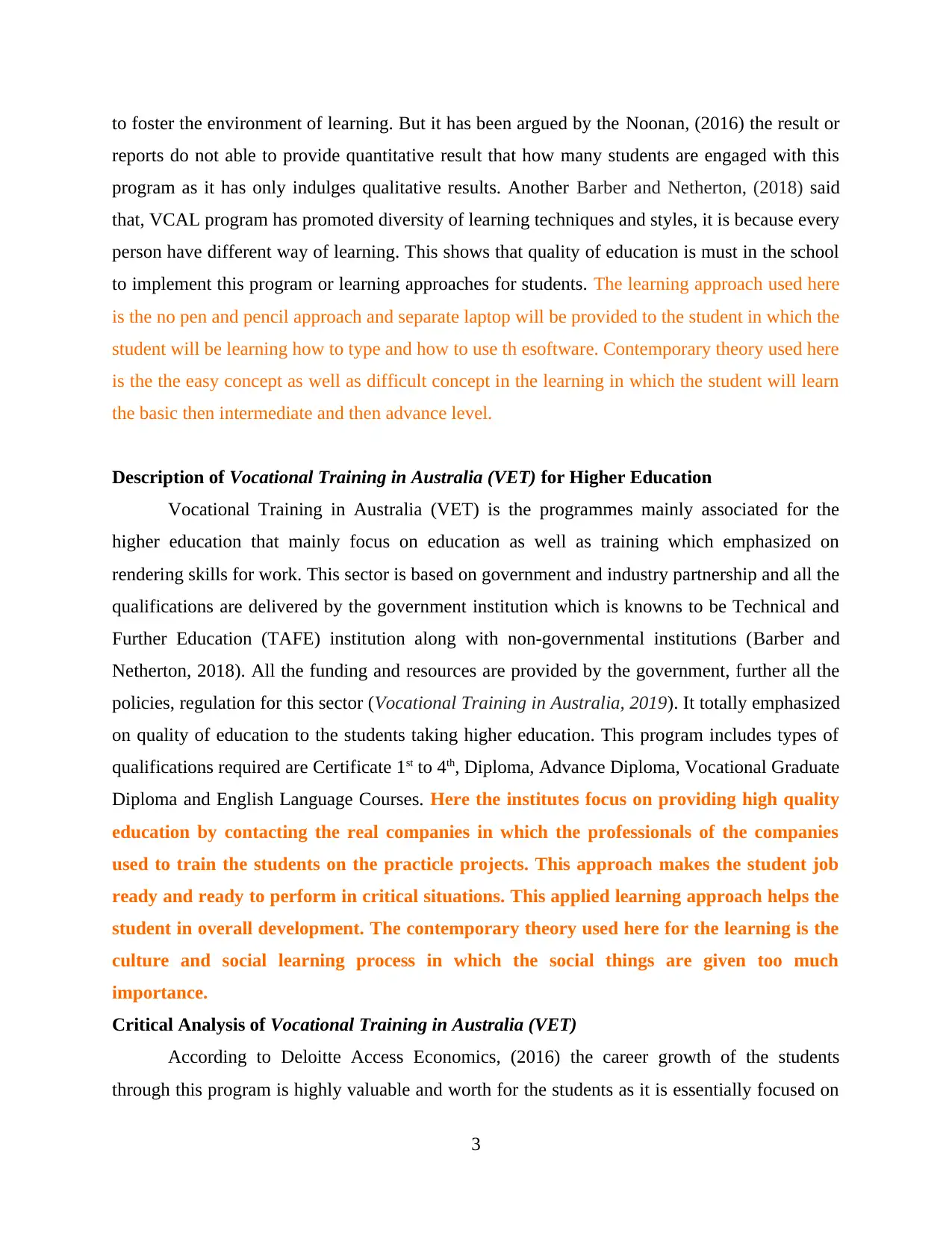
to foster the environment of learning. But it has been argued by the Noonan, (2016) the result or
reports do not able to provide quantitative result that how many students are engaged with this
program as it has only indulges qualitative results. Another Barber and Netherton, (2018) said
that, VCAL program has promoted diversity of learning techniques and styles, it is because every
person have different way of learning. This shows that quality of education is must in the school
to implement this program or learning approaches for students. The learning approach used here
is the no pen and pencil approach and separate laptop will be provided to the student in which the
student will be learning how to type and how to use th esoftware. Contemporary theory used here
is the the easy concept as well as difficult concept in the learning in which the student will learn
the basic then intermediate and then advance level.
Description of Vocational Training in Australia (VET) for Higher Education
Vocational Training in Australia (VET) is the programmes mainly associated for the
higher education that mainly focus on education as well as training which emphasized on
rendering skills for work. This sector is based on government and industry partnership and all the
qualifications are delivered by the government institution which is knowns to be Technical and
Further Education (TAFE) institution along with non-governmental institutions (Barber and
Netherton, 2018). All the funding and resources are provided by the government, further all the
policies, regulation for this sector (Vocational Training in Australia, 2019). It totally emphasized
on quality of education to the students taking higher education. This program includes types of
qualifications required are Certificate 1st to 4th, Diploma, Advance Diploma, Vocational Graduate
Diploma and English Language Courses. Here the institutes focus on providing high quality
education by contacting the real companies in which the professionals of the companies
used to train the students on the practicle projects. This approach makes the student job
ready and ready to perform in critical situations. This applied learning approach helps the
student in overall development. The contemporary theory used here for the learning is the
culture and social learning process in which the social things are given too much
importance.
Critical Analysis of Vocational Training in Australia (VET)
According to Deloitte Access Economics, (2016) the career growth of the students
through this program is highly valuable and worth for the students as it is essentially focused on
3
reports do not able to provide quantitative result that how many students are engaged with this
program as it has only indulges qualitative results. Another Barber and Netherton, (2018) said
that, VCAL program has promoted diversity of learning techniques and styles, it is because every
person have different way of learning. This shows that quality of education is must in the school
to implement this program or learning approaches for students. The learning approach used here
is the no pen and pencil approach and separate laptop will be provided to the student in which the
student will be learning how to type and how to use th esoftware. Contemporary theory used here
is the the easy concept as well as difficult concept in the learning in which the student will learn
the basic then intermediate and then advance level.
Description of Vocational Training in Australia (VET) for Higher Education
Vocational Training in Australia (VET) is the programmes mainly associated for the
higher education that mainly focus on education as well as training which emphasized on
rendering skills for work. This sector is based on government and industry partnership and all the
qualifications are delivered by the government institution which is knowns to be Technical and
Further Education (TAFE) institution along with non-governmental institutions (Barber and
Netherton, 2018). All the funding and resources are provided by the government, further all the
policies, regulation for this sector (Vocational Training in Australia, 2019). It totally emphasized
on quality of education to the students taking higher education. This program includes types of
qualifications required are Certificate 1st to 4th, Diploma, Advance Diploma, Vocational Graduate
Diploma and English Language Courses. Here the institutes focus on providing high quality
education by contacting the real companies in which the professionals of the companies
used to train the students on the practicle projects. This approach makes the student job
ready and ready to perform in critical situations. This applied learning approach helps the
student in overall development. The contemporary theory used here for the learning is the
culture and social learning process in which the social things are given too much
importance.
Critical Analysis of Vocational Training in Australia (VET)
According to Deloitte Access Economics, (2016) the career growth of the students
through this program is highly valuable and worth for the students as it is essentially focused on
3
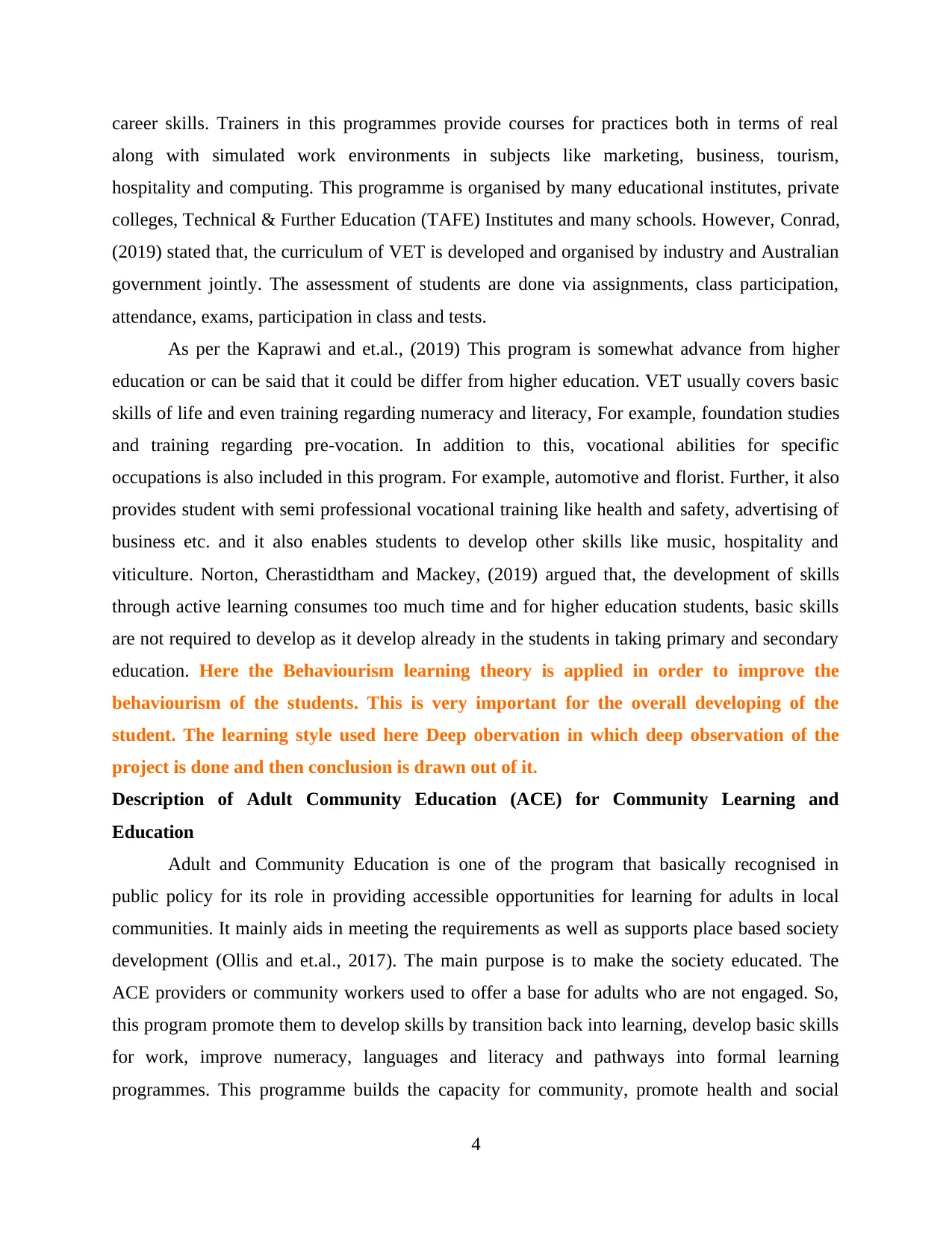
career skills. Trainers in this programmes provide courses for practices both in terms of real
along with simulated work environments in subjects like marketing, business, tourism,
hospitality and computing. This programme is organised by many educational institutes, private
colleges, Technical & Further Education (TAFE) Institutes and many schools. However, Conrad,
(2019) stated that, the curriculum of VET is developed and organised by industry and Australian
government jointly. The assessment of students are done via assignments, class participation,
attendance, exams, participation in class and tests.
As per the Kaprawi and et.al., (2019) This program is somewhat advance from higher
education or can be said that it could be differ from higher education. VET usually covers basic
skills of life and even training regarding numeracy and literacy, For example, foundation studies
and training regarding pre-vocation. In addition to this, vocational abilities for specific
occupations is also included in this program. For example, automotive and florist. Further, it also
provides student with semi professional vocational training like health and safety, advertising of
business etc. and it also enables students to develop other skills like music, hospitality and
viticulture. Norton, Cherastidtham and Mackey, (2019) argued that, the development of skills
through active learning consumes too much time and for higher education students, basic skills
are not required to develop as it develop already in the students in taking primary and secondary
education. Here the Behaviourism learning theory is applied in order to improve the
behaviourism of the students. This is very important for the overall developing of the
student. The learning style used here Deep obervation in which deep observation of the
project is done and then conclusion is drawn out of it.
Description of Adult Community Education (ACE) for Community Learning and
Education
Adult and Community Education is one of the program that basically recognised in
public policy for its role in providing accessible opportunities for learning for adults in local
communities. It mainly aids in meeting the requirements as well as supports place based society
development (Ollis and et.al., 2017). The main purpose is to make the society educated. The
ACE providers or community workers used to offer a base for adults who are not engaged. So,
this program promote them to develop skills by transition back into learning, develop basic skills
for work, improve numeracy, languages and literacy and pathways into formal learning
programmes. This programme builds the capacity for community, promote health and social
4
along with simulated work environments in subjects like marketing, business, tourism,
hospitality and computing. This programme is organised by many educational institutes, private
colleges, Technical & Further Education (TAFE) Institutes and many schools. However, Conrad,
(2019) stated that, the curriculum of VET is developed and organised by industry and Australian
government jointly. The assessment of students are done via assignments, class participation,
attendance, exams, participation in class and tests.
As per the Kaprawi and et.al., (2019) This program is somewhat advance from higher
education or can be said that it could be differ from higher education. VET usually covers basic
skills of life and even training regarding numeracy and literacy, For example, foundation studies
and training regarding pre-vocation. In addition to this, vocational abilities for specific
occupations is also included in this program. For example, automotive and florist. Further, it also
provides student with semi professional vocational training like health and safety, advertising of
business etc. and it also enables students to develop other skills like music, hospitality and
viticulture. Norton, Cherastidtham and Mackey, (2019) argued that, the development of skills
through active learning consumes too much time and for higher education students, basic skills
are not required to develop as it develop already in the students in taking primary and secondary
education. Here the Behaviourism learning theory is applied in order to improve the
behaviourism of the students. This is very important for the overall developing of the
student. The learning style used here Deep obervation in which deep observation of the
project is done and then conclusion is drawn out of it.
Description of Adult Community Education (ACE) for Community Learning and
Education
Adult and Community Education is one of the program that basically recognised in
public policy for its role in providing accessible opportunities for learning for adults in local
communities. It mainly aids in meeting the requirements as well as supports place based society
development (Ollis and et.al., 2017). The main purpose is to make the society educated. The
ACE providers or community workers used to offer a base for adults who are not engaged. So,
this program promote them to develop skills by transition back into learning, develop basic skills
for work, improve numeracy, languages and literacy and pathways into formal learning
programmes. This programme builds the capacity for community, promote health and social
4
⊘ This is a preview!⊘
Do you want full access?
Subscribe today to unlock all pages.

Trusted by 1+ million students worldwide
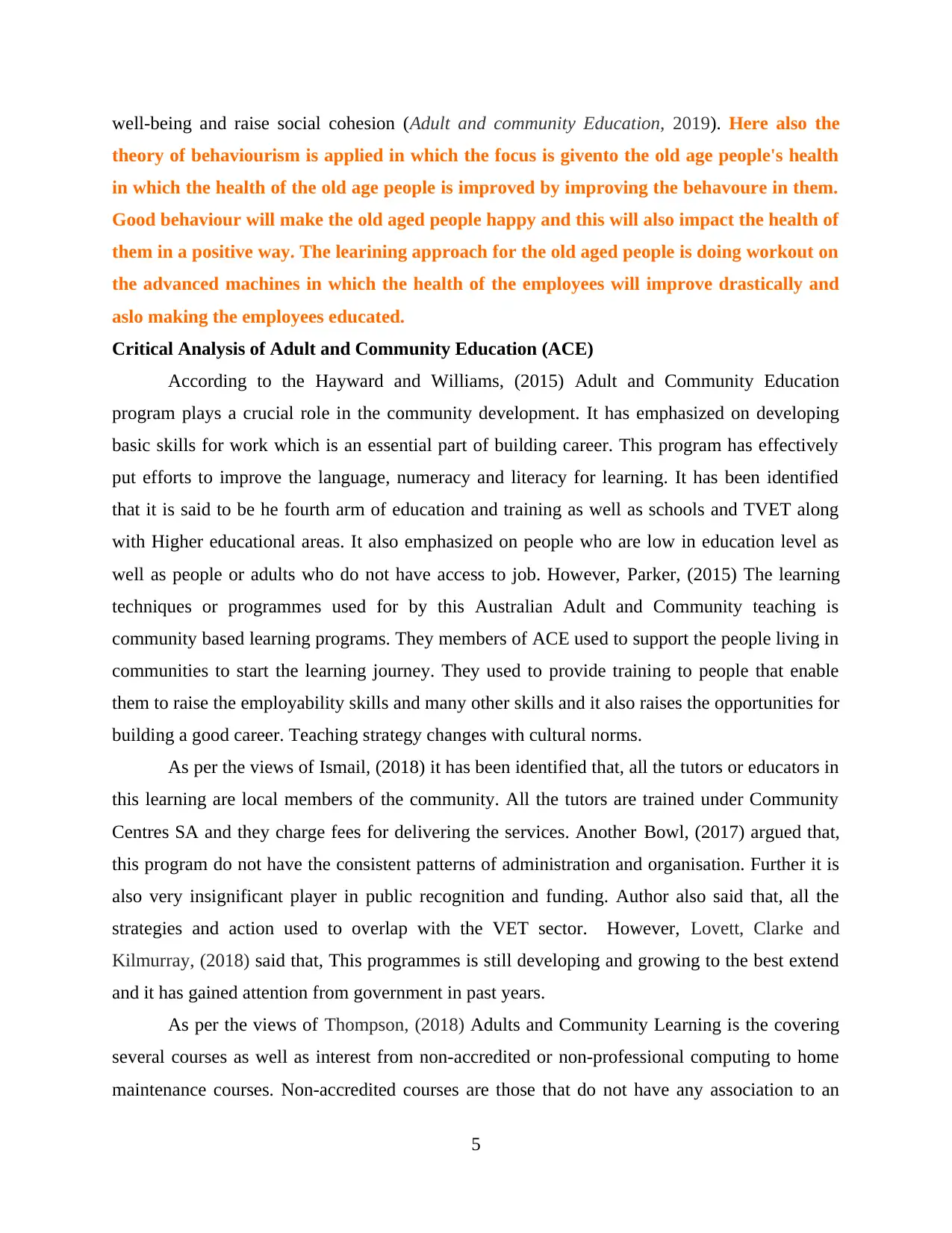
well-being and raise social cohesion (Adult and community Education, 2019). Here also the
theory of behaviourism is applied in which the focus is givento the old age people's health
in which the health of the old age people is improved by improving the behavoure in them.
Good behaviour will make the old aged people happy and this will also impact the health of
them in a positive way. The learining approach for the old aged people is doing workout on
the advanced machines in which the health of the employees will improve drastically and
aslo making the employees educated.
Critical Analysis of Adult and Community Education (ACE)
According to the Hayward and Williams, (2015) Adult and Community Education
program plays a crucial role in the community development. It has emphasized on developing
basic skills for work which is an essential part of building career. This program has effectively
put efforts to improve the language, numeracy and literacy for learning. It has been identified
that it is said to be he fourth arm of education and training as well as schools and TVET along
with Higher educational areas. It also emphasized on people who are low in education level as
well as people or adults who do not have access to job. However, Parker, (2015) The learning
techniques or programmes used for by this Australian Adult and Community teaching is
community based learning programs. They members of ACE used to support the people living in
communities to start the learning journey. They used to provide training to people that enable
them to raise the employability skills and many other skills and it also raises the opportunities for
building a good career. Teaching strategy changes with cultural norms.
As per the views of Ismail, (2018) it has been identified that, all the tutors or educators in
this learning are local members of the community. All the tutors are trained under Community
Centres SA and they charge fees for delivering the services. Another Bowl, (2017) argued that,
this program do not have the consistent patterns of administration and organisation. Further it is
also very insignificant player in public recognition and funding. Author also said that, all the
strategies and action used to overlap with the VET sector. However, Lovett, Clarke and
Kilmurray, (2018) said that, This programmes is still developing and growing to the best extend
and it has gained attention from government in past years.
As per the views of Thompson, (2018) Adults and Community Learning is the covering
several courses as well as interest from non-accredited or non-professional computing to home
maintenance courses. Non-accredited courses are those that do not have any association to an
5
theory of behaviourism is applied in which the focus is givento the old age people's health
in which the health of the old age people is improved by improving the behavoure in them.
Good behaviour will make the old aged people happy and this will also impact the health of
them in a positive way. The learining approach for the old aged people is doing workout on
the advanced machines in which the health of the employees will improve drastically and
aslo making the employees educated.
Critical Analysis of Adult and Community Education (ACE)
According to the Hayward and Williams, (2015) Adult and Community Education
program plays a crucial role in the community development. It has emphasized on developing
basic skills for work which is an essential part of building career. This program has effectively
put efforts to improve the language, numeracy and literacy for learning. It has been identified
that it is said to be he fourth arm of education and training as well as schools and TVET along
with Higher educational areas. It also emphasized on people who are low in education level as
well as people or adults who do not have access to job. However, Parker, (2015) The learning
techniques or programmes used for by this Australian Adult and Community teaching is
community based learning programs. They members of ACE used to support the people living in
communities to start the learning journey. They used to provide training to people that enable
them to raise the employability skills and many other skills and it also raises the opportunities for
building a good career. Teaching strategy changes with cultural norms.
As per the views of Ismail, (2018) it has been identified that, all the tutors or educators in
this learning are local members of the community. All the tutors are trained under Community
Centres SA and they charge fees for delivering the services. Another Bowl, (2017) argued that,
this program do not have the consistent patterns of administration and organisation. Further it is
also very insignificant player in public recognition and funding. Author also said that, all the
strategies and action used to overlap with the VET sector. However, Lovett, Clarke and
Kilmurray, (2018) said that, This programmes is still developing and growing to the best extend
and it has gained attention from government in past years.
As per the views of Thompson, (2018) Adults and Community Learning is the covering
several courses as well as interest from non-accredited or non-professional computing to home
maintenance courses. Non-accredited courses are those that do not have any association to an
5
Paraphrase This Document
Need a fresh take? Get an instant paraphrase of this document with our AI Paraphraser
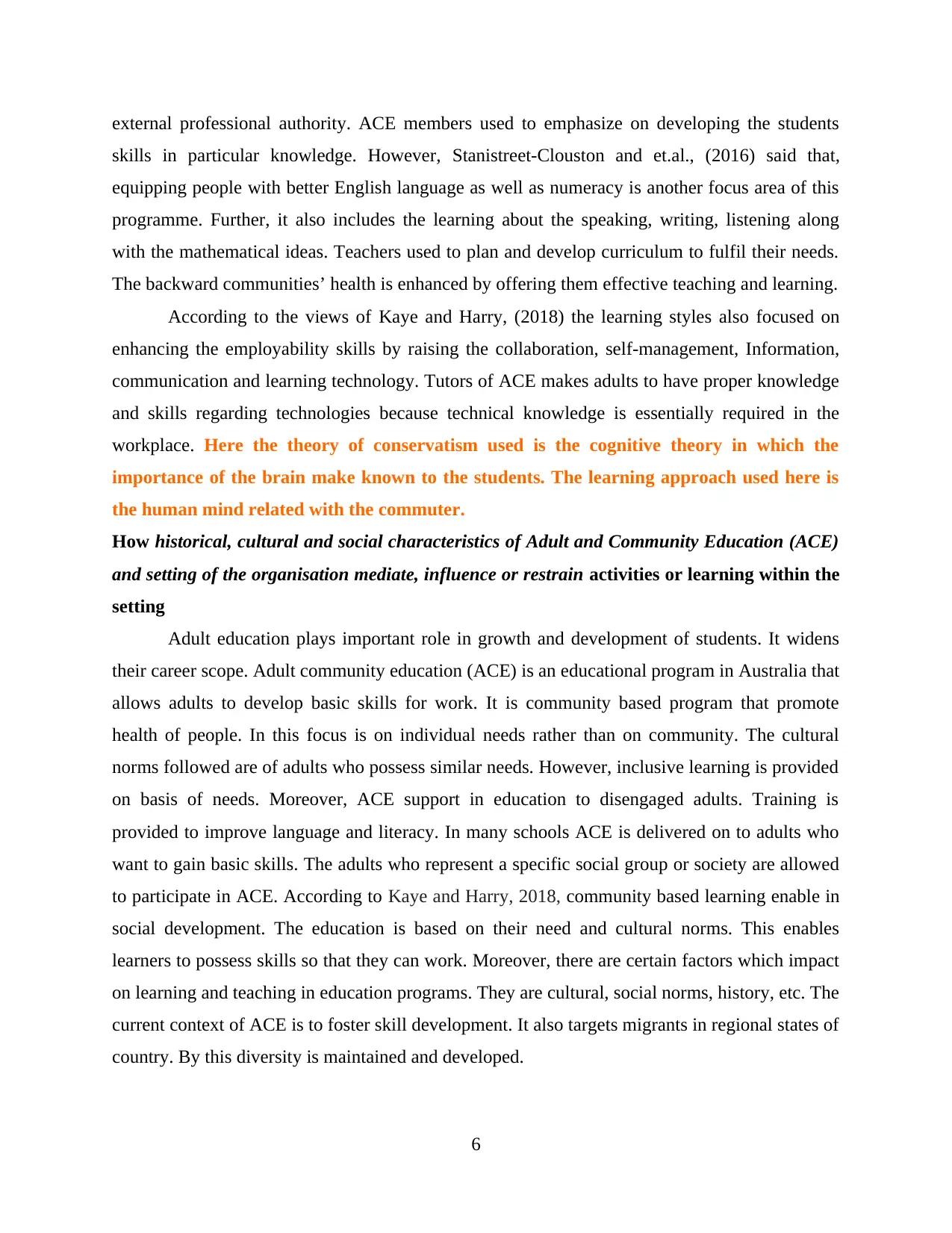
external professional authority. ACE members used to emphasize on developing the students
skills in particular knowledge. However, Stanistreet-Clouston and et.al., (2016) said that,
equipping people with better English language as well as numeracy is another focus area of this
programme. Further, it also includes the learning about the speaking, writing, listening along
with the mathematical ideas. Teachers used to plan and develop curriculum to fulfil their needs.
The backward communities’ health is enhanced by offering them effective teaching and learning.
According to the views of Kaye and Harry, (2018) the learning styles also focused on
enhancing the employability skills by raising the collaboration, self-management, Information,
communication and learning technology. Tutors of ACE makes adults to have proper knowledge
and skills regarding technologies because technical knowledge is essentially required in the
workplace. Here the theory of conservatism used is the cognitive theory in which the
importance of the brain make known to the students. The learning approach used here is
the human mind related with the commuter.
How historical, cultural and social characteristics of Adult and Community Education (ACE)
and setting of the organisation mediate, influence or restrain activities or learning within the
setting
Adult education plays important role in growth and development of students. It widens
their career scope. Adult community education (ACE) is an educational program in Australia that
allows adults to develop basic skills for work. It is community based program that promote
health of people. In this focus is on individual needs rather than on community. The cultural
norms followed are of adults who possess similar needs. However, inclusive learning is provided
on basis of needs. Moreover, ACE support in education to disengaged adults. Training is
provided to improve language and literacy. In many schools ACE is delivered on to adults who
want to gain basic skills. The adults who represent a specific social group or society are allowed
to participate in ACE. According to Kaye and Harry, 2018, community based learning enable in
social development. The education is based on their need and cultural norms. This enables
learners to possess skills so that they can work. Moreover, there are certain factors which impact
on learning and teaching in education programs. They are cultural, social norms, history, etc. The
current context of ACE is to foster skill development. It also targets migrants in regional states of
country. By this diversity is maintained and developed.
6
skills in particular knowledge. However, Stanistreet-Clouston and et.al., (2016) said that,
equipping people with better English language as well as numeracy is another focus area of this
programme. Further, it also includes the learning about the speaking, writing, listening along
with the mathematical ideas. Teachers used to plan and develop curriculum to fulfil their needs.
The backward communities’ health is enhanced by offering them effective teaching and learning.
According to the views of Kaye and Harry, (2018) the learning styles also focused on
enhancing the employability skills by raising the collaboration, self-management, Information,
communication and learning technology. Tutors of ACE makes adults to have proper knowledge
and skills regarding technologies because technical knowledge is essentially required in the
workplace. Here the theory of conservatism used is the cognitive theory in which the
importance of the brain make known to the students. The learning approach used here is
the human mind related with the commuter.
How historical, cultural and social characteristics of Adult and Community Education (ACE)
and setting of the organisation mediate, influence or restrain activities or learning within the
setting
Adult education plays important role in growth and development of students. It widens
their career scope. Adult community education (ACE) is an educational program in Australia that
allows adults to develop basic skills for work. It is community based program that promote
health of people. In this focus is on individual needs rather than on community. The cultural
norms followed are of adults who possess similar needs. However, inclusive learning is provided
on basis of needs. Moreover, ACE support in education to disengaged adults. Training is
provided to improve language and literacy. In many schools ACE is delivered on to adults who
want to gain basic skills. The adults who represent a specific social group or society are allowed
to participate in ACE. According to Kaye and Harry, 2018, community based learning enable in
social development. The education is based on their need and cultural norms. This enables
learners to possess skills so that they can work. Moreover, there are certain factors which impact
on learning and teaching in education programs. They are cultural, social norms, history, etc. The
current context of ACE is to foster skill development. It also targets migrants in regional states of
country. By this diversity is maintained and developed.
6
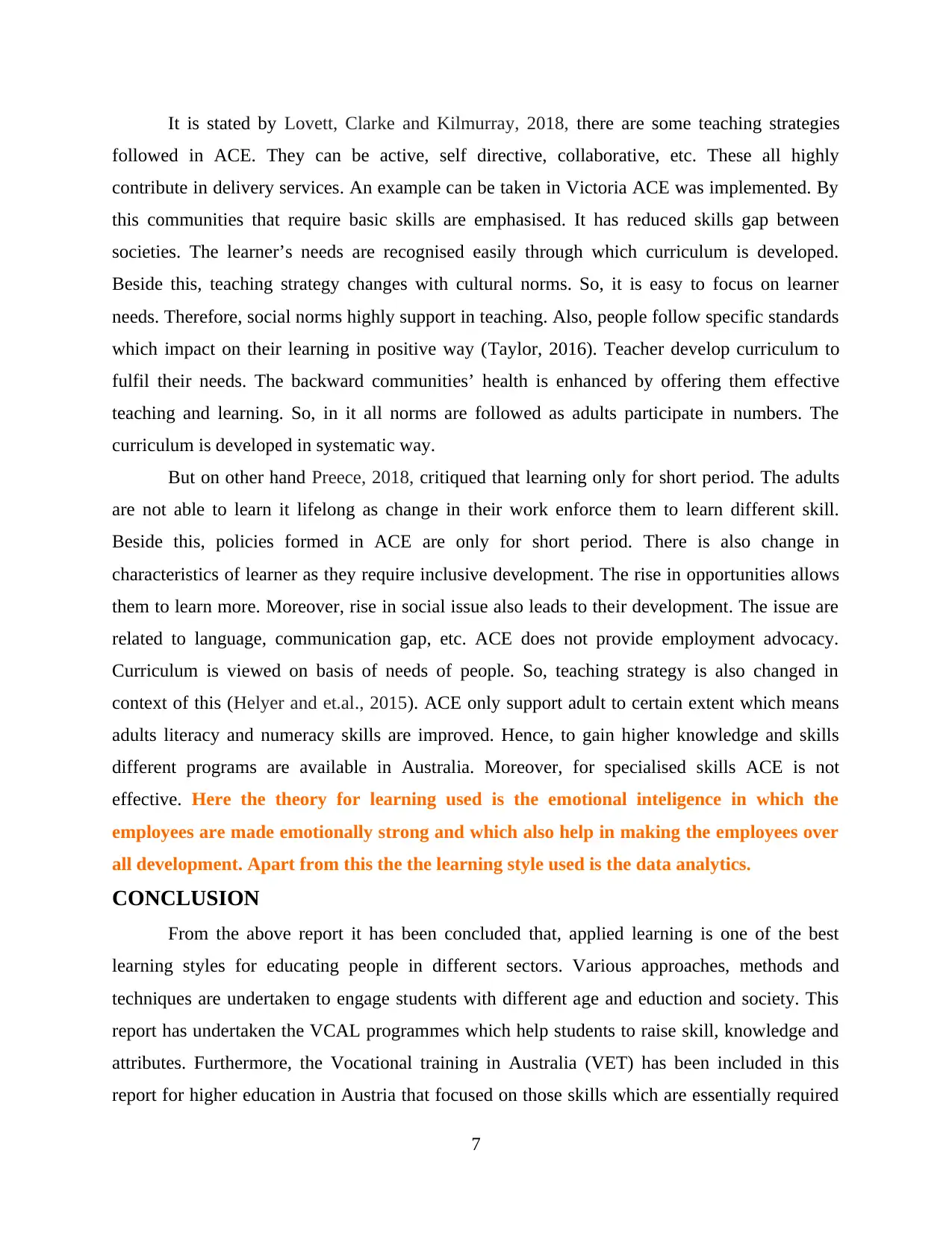
It is stated by Lovett, Clarke and Kilmurray, 2018, there are some teaching strategies
followed in ACE. They can be active, self directive, collaborative, etc. These all highly
contribute in delivery services. An example can be taken in Victoria ACE was implemented. By
this communities that require basic skills are emphasised. It has reduced skills gap between
societies. The learner’s needs are recognised easily through which curriculum is developed.
Beside this, teaching strategy changes with cultural norms. So, it is easy to focus on learner
needs. Therefore, social norms highly support in teaching. Also, people follow specific standards
which impact on their learning in positive way (Taylor, 2016). Teacher develop curriculum to
fulfil their needs. The backward communities’ health is enhanced by offering them effective
teaching and learning. So, in it all norms are followed as adults participate in numbers. The
curriculum is developed in systematic way.
But on other hand Preece, 2018, critiqued that learning only for short period. The adults
are not able to learn it lifelong as change in their work enforce them to learn different skill.
Beside this, policies formed in ACE are only for short period. There is also change in
characteristics of learner as they require inclusive development. The rise in opportunities allows
them to learn more. Moreover, rise in social issue also leads to their development. The issue are
related to language, communication gap, etc. ACE does not provide employment advocacy.
Curriculum is viewed on basis of needs of people. So, teaching strategy is also changed in
context of this (Helyer and et.al., 2015). ACE only support adult to certain extent which means
adults literacy and numeracy skills are improved. Hence, to gain higher knowledge and skills
different programs are available in Australia. Moreover, for specialised skills ACE is not
effective. Here the theory for learning used is the emotional inteligence in which the
employees are made emotionally strong and which also help in making the employees over
all development. Apart from this the the learning style used is the data analytics.
CONCLUSION
From the above report it has been concluded that, applied learning is one of the best
learning styles for educating people in different sectors. Various approaches, methods and
techniques are undertaken to engage students with different age and eduction and society. This
report has undertaken the VCAL programmes which help students to raise skill, knowledge and
attributes. Furthermore, the Vocational training in Australia (VET) has been included in this
report for higher education in Austria that focused on those skills which are essentially required
7
followed in ACE. They can be active, self directive, collaborative, etc. These all highly
contribute in delivery services. An example can be taken in Victoria ACE was implemented. By
this communities that require basic skills are emphasised. It has reduced skills gap between
societies. The learner’s needs are recognised easily through which curriculum is developed.
Beside this, teaching strategy changes with cultural norms. So, it is easy to focus on learner
needs. Therefore, social norms highly support in teaching. Also, people follow specific standards
which impact on their learning in positive way (Taylor, 2016). Teacher develop curriculum to
fulfil their needs. The backward communities’ health is enhanced by offering them effective
teaching and learning. So, in it all norms are followed as adults participate in numbers. The
curriculum is developed in systematic way.
But on other hand Preece, 2018, critiqued that learning only for short period. The adults
are not able to learn it lifelong as change in their work enforce them to learn different skill.
Beside this, policies formed in ACE are only for short period. There is also change in
characteristics of learner as they require inclusive development. The rise in opportunities allows
them to learn more. Moreover, rise in social issue also leads to their development. The issue are
related to language, communication gap, etc. ACE does not provide employment advocacy.
Curriculum is viewed on basis of needs of people. So, teaching strategy is also changed in
context of this (Helyer and et.al., 2015). ACE only support adult to certain extent which means
adults literacy and numeracy skills are improved. Hence, to gain higher knowledge and skills
different programs are available in Australia. Moreover, for specialised skills ACE is not
effective. Here the theory for learning used is the emotional inteligence in which the
employees are made emotionally strong and which also help in making the employees over
all development. Apart from this the the learning style used is the data analytics.
CONCLUSION
From the above report it has been concluded that, applied learning is one of the best
learning styles for educating people in different sectors. Various approaches, methods and
techniques are undertaken to engage students with different age and eduction and society. This
report has undertaken the VCAL programmes which help students to raise skill, knowledge and
attributes. Furthermore, the Vocational training in Australia (VET) has been included in this
report for higher education in Austria that focused on those skills which are essentially required
7
⊘ This is a preview!⊘
Do you want full access?
Subscribe today to unlock all pages.

Trusted by 1+ million students worldwide
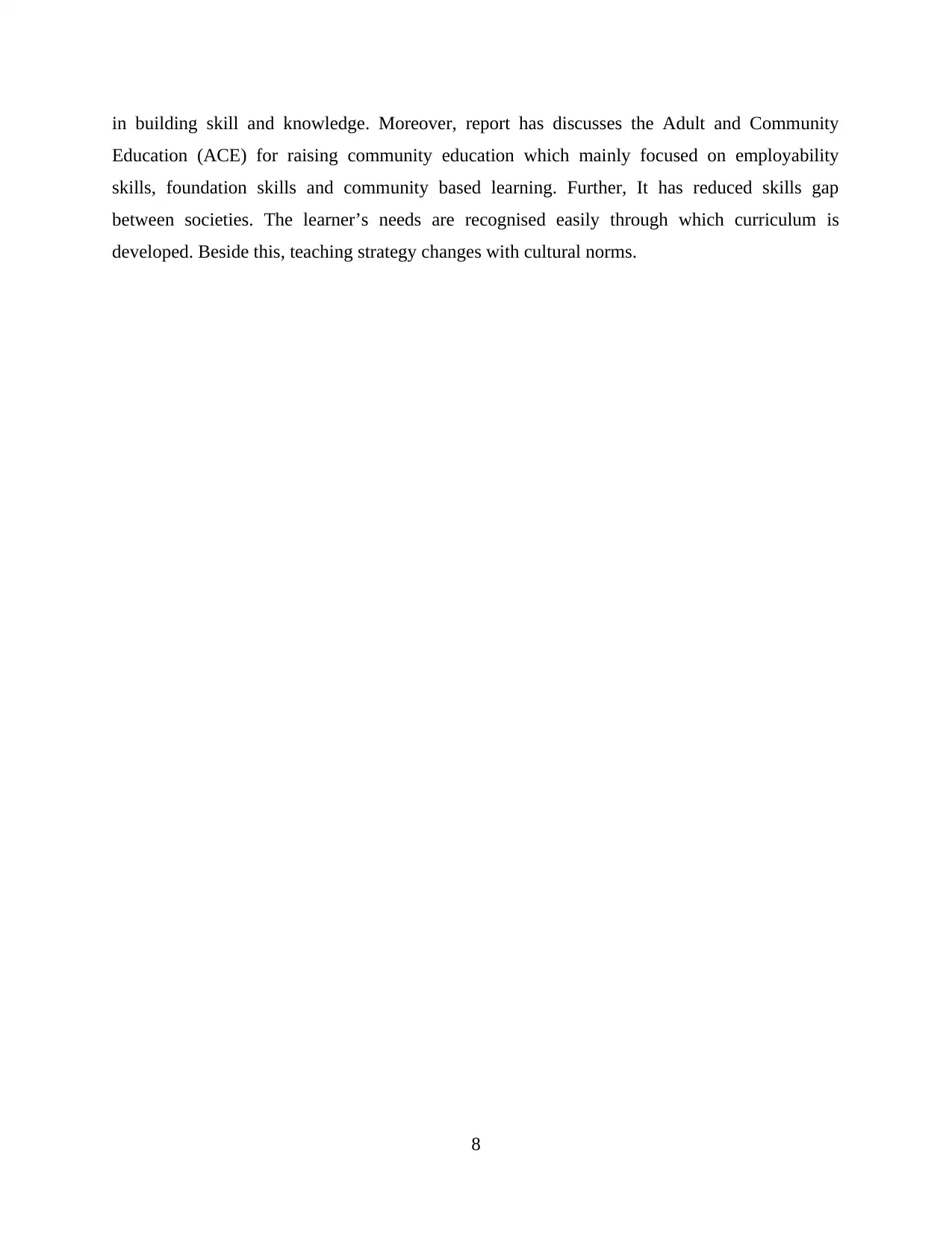
in building skill and knowledge. Moreover, report has discusses the Adult and Community
Education (ACE) for raising community education which mainly focused on employability
skills, foundation skills and community based learning. Further, It has reduced skills gap
between societies. The learner’s needs are recognised easily through which curriculum is
developed. Beside this, teaching strategy changes with cultural norms.
8
Education (ACE) for raising community education which mainly focused on employability
skills, foundation skills and community based learning. Further, It has reduced skills gap
between societies. The learner’s needs are recognised easily through which curriculum is
developed. Beside this, teaching strategy changes with cultural norms.
8
Paraphrase This Document
Need a fresh take? Get an instant paraphrase of this document with our AI Paraphraser
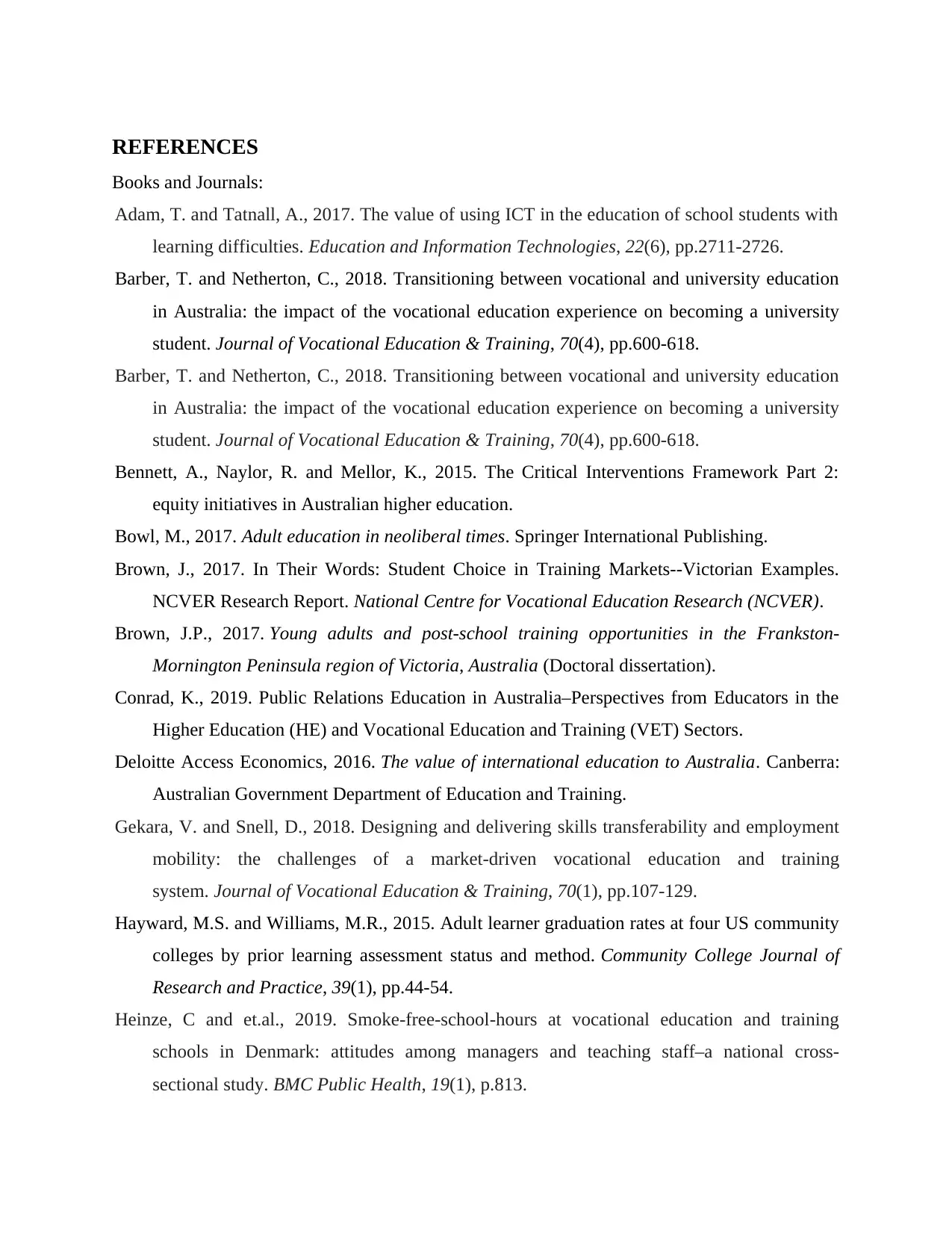
REFERENCES
Books and Journals:
Adam, T. and Tatnall, A., 2017. The value of using ICT in the education of school students with
learning difficulties. Education and Information Technologies, 22(6), pp.2711-2726.
Barber, T. and Netherton, C., 2018. Transitioning between vocational and university education
in Australia: the impact of the vocational education experience on becoming a university
student. Journal of Vocational Education & Training, 70(4), pp.600-618.
Barber, T. and Netherton, C., 2018. Transitioning between vocational and university education
in Australia: the impact of the vocational education experience on becoming a university
student. Journal of Vocational Education & Training, 70(4), pp.600-618.
Bennett, A., Naylor, R. and Mellor, K., 2015. The Critical Interventions Framework Part 2:
equity initiatives in Australian higher education.
Bowl, M., 2017. Adult education in neoliberal times. Springer International Publishing.
Brown, J., 2017. In Their Words: Student Choice in Training Markets--Victorian Examples.
NCVER Research Report. National Centre for Vocational Education Research (NCVER).
Brown, J.P., 2017. Young adults and post-school training opportunities in the Frankston-
Mornington Peninsula region of Victoria, Australia (Doctoral dissertation).
Conrad, K., 2019. Public Relations Education in Australia–Perspectives from Educators in the
Higher Education (HE) and Vocational Education and Training (VET) Sectors.
Deloitte Access Economics, 2016. The value of international education to Australia. Canberra:
Australian Government Department of Education and Training.
Gekara, V. and Snell, D., 2018. Designing and delivering skills transferability and employment
mobility: the challenges of a market-driven vocational education and training
system. Journal of Vocational Education & Training, 70(1), pp.107-129.
Hayward, M.S. and Williams, M.R., 2015. Adult learner graduation rates at four US community
colleges by prior learning assessment status and method. Community College Journal of
Research and Practice, 39(1), pp.44-54.
Heinze, C and et.al., 2019. Smoke-free-school-hours at vocational education and training
schools in Denmark: attitudes among managers and teaching staff–a national cross-
sectional study. BMC Public Health, 19(1), p.813.
Books and Journals:
Adam, T. and Tatnall, A., 2017. The value of using ICT in the education of school students with
learning difficulties. Education and Information Technologies, 22(6), pp.2711-2726.
Barber, T. and Netherton, C., 2018. Transitioning between vocational and university education
in Australia: the impact of the vocational education experience on becoming a university
student. Journal of Vocational Education & Training, 70(4), pp.600-618.
Barber, T. and Netherton, C., 2018. Transitioning between vocational and university education
in Australia: the impact of the vocational education experience on becoming a university
student. Journal of Vocational Education & Training, 70(4), pp.600-618.
Bennett, A., Naylor, R. and Mellor, K., 2015. The Critical Interventions Framework Part 2:
equity initiatives in Australian higher education.
Bowl, M., 2017. Adult education in neoliberal times. Springer International Publishing.
Brown, J., 2017. In Their Words: Student Choice in Training Markets--Victorian Examples.
NCVER Research Report. National Centre for Vocational Education Research (NCVER).
Brown, J.P., 2017. Young adults and post-school training opportunities in the Frankston-
Mornington Peninsula region of Victoria, Australia (Doctoral dissertation).
Conrad, K., 2019. Public Relations Education in Australia–Perspectives from Educators in the
Higher Education (HE) and Vocational Education and Training (VET) Sectors.
Deloitte Access Economics, 2016. The value of international education to Australia. Canberra:
Australian Government Department of Education and Training.
Gekara, V. and Snell, D., 2018. Designing and delivering skills transferability and employment
mobility: the challenges of a market-driven vocational education and training
system. Journal of Vocational Education & Training, 70(1), pp.107-129.
Hayward, M.S. and Williams, M.R., 2015. Adult learner graduation rates at four US community
colleges by prior learning assessment status and method. Community College Journal of
Research and Practice, 39(1), pp.44-54.
Heinze, C and et.al., 2019. Smoke-free-school-hours at vocational education and training
schools in Denmark: attitudes among managers and teaching staff–a national cross-
sectional study. BMC Public Health, 19(1), p.813.
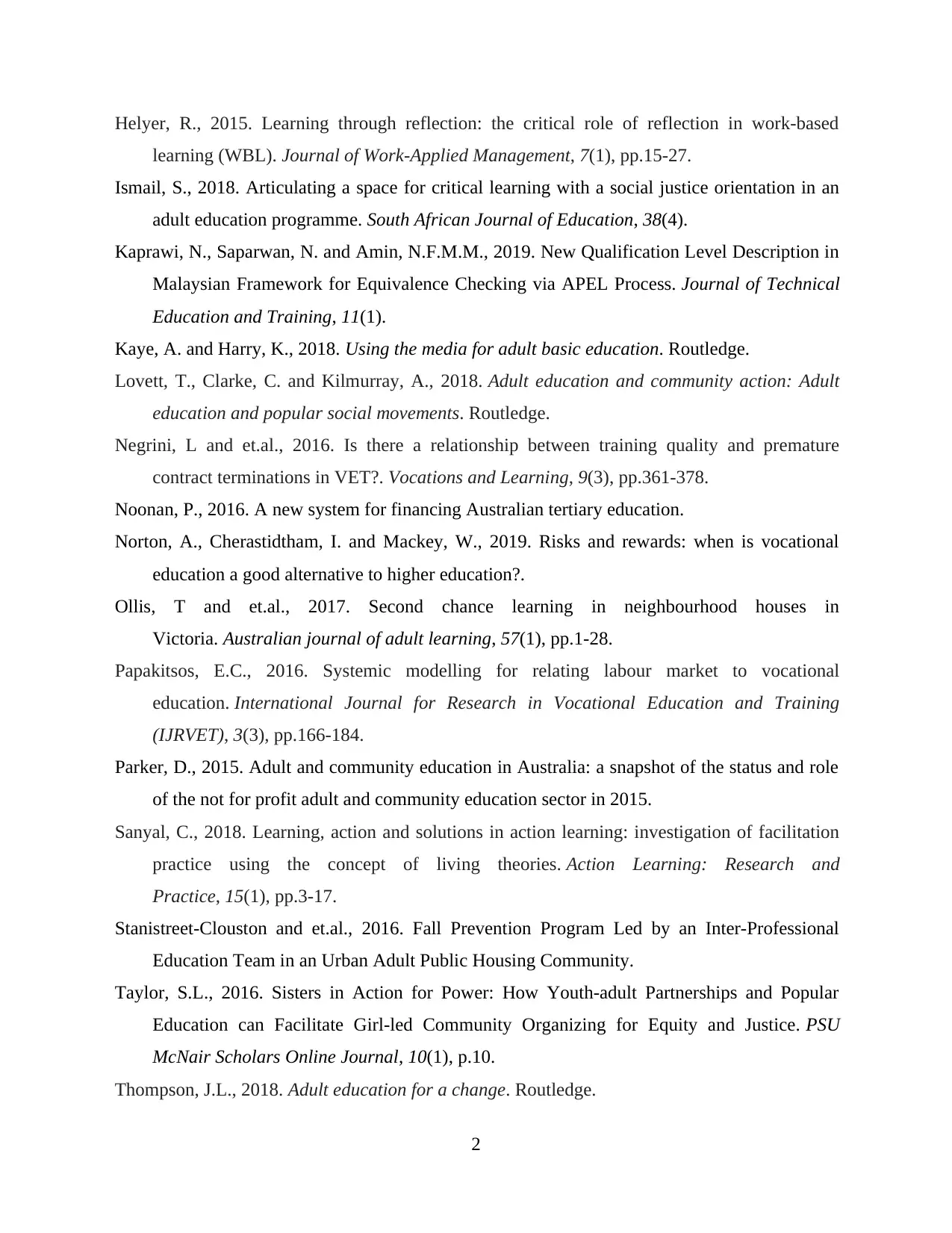
Helyer, R., 2015. Learning through reflection: the critical role of reflection in work-based
learning (WBL). Journal of Work-Applied Management, 7(1), pp.15-27.
Ismail, S., 2018. Articulating a space for critical learning with a social justice orientation in an
adult education programme. South African Journal of Education, 38(4).
Kaprawi, N., Saparwan, N. and Amin, N.F.M.M., 2019. New Qualification Level Description in
Malaysian Framework for Equivalence Checking via APEL Process. Journal of Technical
Education and Training, 11(1).
Kaye, A. and Harry, K., 2018. Using the media for adult basic education. Routledge.
Lovett, T., Clarke, C. and Kilmurray, A., 2018. Adult education and community action: Adult
education and popular social movements. Routledge.
Negrini, L and et.al., 2016. Is there a relationship between training quality and premature
contract terminations in VET?. Vocations and Learning, 9(3), pp.361-378.
Noonan, P., 2016. A new system for financing Australian tertiary education.
Norton, A., Cherastidtham, I. and Mackey, W., 2019. Risks and rewards: when is vocational
education a good alternative to higher education?.
Ollis, T and et.al., 2017. Second chance learning in neighbourhood houses in
Victoria. Australian journal of adult learning, 57(1), pp.1-28.
Papakitsos, E.C., 2016. Systemic modelling for relating labour market to vocational
education. International Journal for Research in Vocational Education and Training
(IJRVET), 3(3), pp.166-184.
Parker, D., 2015. Adult and community education in Australia: a snapshot of the status and role
of the not for profit adult and community education sector in 2015.
Sanyal, C., 2018. Learning, action and solutions in action learning: investigation of facilitation
practice using the concept of living theories. Action Learning: Research and
Practice, 15(1), pp.3-17.
Stanistreet-Clouston and et.al., 2016. Fall Prevention Program Led by an Inter-Professional
Education Team in an Urban Adult Public Housing Community.
Taylor, S.L., 2016. Sisters in Action for Power: How Youth-adult Partnerships and Popular
Education can Facilitate Girl-led Community Organizing for Equity and Justice. PSU
McNair Scholars Online Journal, 10(1), p.10.
Thompson, J.L., 2018. Adult education for a change. Routledge.
2
learning (WBL). Journal of Work-Applied Management, 7(1), pp.15-27.
Ismail, S., 2018. Articulating a space for critical learning with a social justice orientation in an
adult education programme. South African Journal of Education, 38(4).
Kaprawi, N., Saparwan, N. and Amin, N.F.M.M., 2019. New Qualification Level Description in
Malaysian Framework for Equivalence Checking via APEL Process. Journal of Technical
Education and Training, 11(1).
Kaye, A. and Harry, K., 2018. Using the media for adult basic education. Routledge.
Lovett, T., Clarke, C. and Kilmurray, A., 2018. Adult education and community action: Adult
education and popular social movements. Routledge.
Negrini, L and et.al., 2016. Is there a relationship between training quality and premature
contract terminations in VET?. Vocations and Learning, 9(3), pp.361-378.
Noonan, P., 2016. A new system for financing Australian tertiary education.
Norton, A., Cherastidtham, I. and Mackey, W., 2019. Risks and rewards: when is vocational
education a good alternative to higher education?.
Ollis, T and et.al., 2017. Second chance learning in neighbourhood houses in
Victoria. Australian journal of adult learning, 57(1), pp.1-28.
Papakitsos, E.C., 2016. Systemic modelling for relating labour market to vocational
education. International Journal for Research in Vocational Education and Training
(IJRVET), 3(3), pp.166-184.
Parker, D., 2015. Adult and community education in Australia: a snapshot of the status and role
of the not for profit adult and community education sector in 2015.
Sanyal, C., 2018. Learning, action and solutions in action learning: investigation of facilitation
practice using the concept of living theories. Action Learning: Research and
Practice, 15(1), pp.3-17.
Stanistreet-Clouston and et.al., 2016. Fall Prevention Program Led by an Inter-Professional
Education Team in an Urban Adult Public Housing Community.
Taylor, S.L., 2016. Sisters in Action for Power: How Youth-adult Partnerships and Popular
Education can Facilitate Girl-led Community Organizing for Equity and Justice. PSU
McNair Scholars Online Journal, 10(1), p.10.
Thompson, J.L., 2018. Adult education for a change. Routledge.
2
⊘ This is a preview!⊘
Do you want full access?
Subscribe today to unlock all pages.

Trusted by 1+ million students worldwide
1 out of 13
Related Documents
Your All-in-One AI-Powered Toolkit for Academic Success.
+13062052269
info@desklib.com
Available 24*7 on WhatsApp / Email
![[object Object]](/_next/static/media/star-bottom.7253800d.svg)
Unlock your academic potential
Copyright © 2020–2025 A2Z Services. All Rights Reserved. Developed and managed by ZUCOL.





